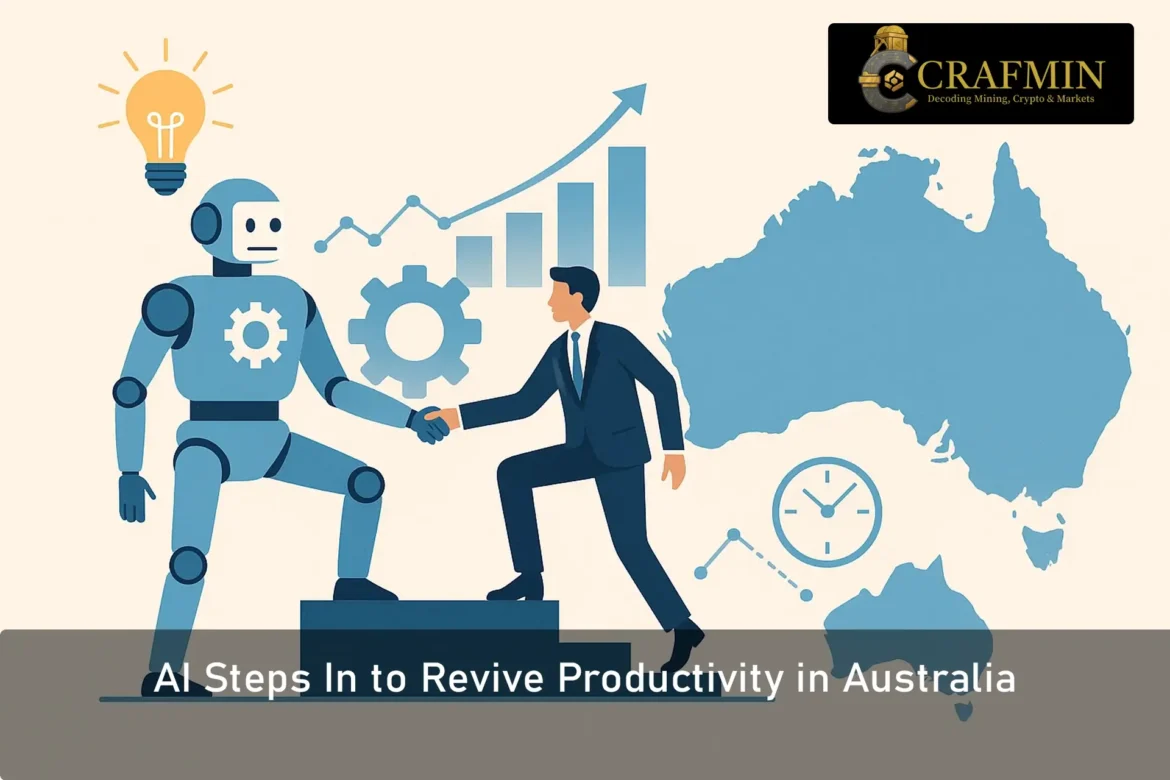Australia is at a critical juncture. After years of slow productivity growth, artificial intelligence is now emerging as a potential game-changer. The Productivity Commission is currently gathering insights across the country to understand how businesses and workers can use AI to achieve greater efficiency with less effort.
At the heart of this national conversation is a big question: Can AI help Australia overcome its productivity slump? The early signs suggest that it can—with the right tools, training, and strategy in place.

AI drives a new wave of productivity in Australia ( Image Source: Information Age | ACS )
What’s Slowing Us Down?
Labour productivity in Australia has been underwhelming. Workers are finding it harder to produce more output or higher value with the same level of effort and resources. Despite ongoing investments in training and infrastructure, the results have been lacklustre.
This is where artificial intelligence comes in. Like a power tool for the mind, AI offers a way to extend human capability. Whether it’s through automated data analysis, streamlined design work, or predictive systems, AI has the potential to free up time, reduce error, and amplify outcomes.
From Film Sets to Office Desks: Real-Life AI Applications
Australians are already finding creative ways to use AI in their daily work. In the media industry, for instance, professionals use AI tools to generate visual backdrops for film sets, dramatically cutting the time needed for production. In marketing, AI creates actor profiles and design elements, allowing teams to work faster and leaner.
And it’s not just about creative industries. In customer service, AI-powered assistants help representatives resolve more inquiries in less time. Managers use AI to simulate business strategies and optimise logistics. These aren’t futuristic fantasies — they’re real, measurable shifts happening in workplaces today.
From Film Sets to Offices: Real-World Uses of AI ( Image Source: Vitrina )
Accountability Matters: Who Pays When AI Fails?
With all its promise, AI also raises tough questions. What happens when it makes a mistake? If an AI tool generates an incorrect report, misjudges a safety hazard, or produces flawed content, who’s to blame?
Right now, responsibility often falls on the end user. But some experts argue that this isn’t sustainable. Much like car manufacturers are responsible for airbag malfunctions, AI developers might need to shoulder more of the legal and ethical burden. Without clear rules, businesses may be hesitant to adopt AI widely, fearing liability and risk.
https://youtu.be/UqllSjkZJ9k?si=UElBx45z4WwNe0iW
Regulation vs. Innovation: Finding the Balance
Technology is evolving fast—sometimes faster than the laws that aim to regulate it. Capabilities that seemed impossible just a year ago are now commonplace. This creates a risk that regulation may fall behind or fail to reflect how the technology is actually being used.
The Productivity Commission warns against heavy-handed rules that could stifle innovation or cement the dominance of big tech players. Instead, it recommends a balanced approach—one that encourages growth and experimentation while protecting the rights and safety of users.
What the Commission Is Planning
To steer the conversation forward, the Productivity Commission will release an interim report in August. This report will outline key findings from public consultations and offer recommendations for businesses, workers, and policymakers.
The goal is to ensure that AI’s adoption leads to genuine productivity gains—not just hype. It’s about giving Australians the tools they need to work smarter, and setting clear guidelines for how these tools should be developed and used.
Also Read: AI at Cannes Lions 2025: Marketers Demand Practical AI Solutions
Why This Conversation Matters Now
The global economy is shifting. With inflationary pressure, a rapidly ageing workforce, and increasing international competition, Australia must find new ways to boost its output. AI could be one of the most powerful tools in that effort.
Picture a logistics manager in Brisbane using AI to optimise delivery routes and reduce fuel use. Or a financial planner in Perth automating routine client reports to focus more on strategic advice. Across industries, from manufacturing to marketing, AI has the potential to reduce inefficiencies and elevate human performance.
Fairness and Future-Proofing Jobs
AI’s rise doesn’t just bring technical challenges — it also raises social concerns. If not handled correctly, automation could deepen wage inequality or replace meaningful work. That’s why it’s essential for any AI strategy to also include the voices of everyday workers.
The Commission is aiming for an inclusive approach — one that boosts productivity while ensuring fairness, transparency, and long-term employment stability.
A Turning Point for the Workforce
Artificial intelligence is not just another digital fad. It’s a transformative force that could reshape how Australians work — and how the economy grows. The potential for a true AI productivity boost is real, but it requires careful planning and shared responsibility.
This isn’t about replacing humans. It’s about enabling them to do their best work — faster, smarter, and with fewer barriers.
What’s Coming Next?
- Interim Report: Due in August
- Nationwide Input: More feedback from businesses and workers
- Policy Changes: Likely to follow based on findings
Final Thought
AI holds the potential to solve one of Australia’s biggest economic puzzles: how to do more with the same. As momentum builds, the focus must remain on using technology to support—not supplant—human effort. That’s the real productivity revolution.

